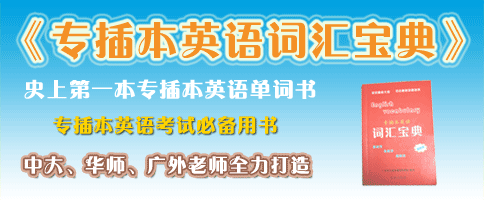英语专业《综合英语》专插本考试大纲
英语专业《英汉翻译》本科插班考试大纲
英语专业《英语语法》专插本考试大纲
2014本科插班生考试大纲 (考试科目:翻译) Ⅰ考试性质 普通高等学校本科插班生(又称专插本)招生考试是由专科毕业生参加的选拔性考试。高等学校根据考生的成绩,按照已确定的招生计划,德、智、体全面衡量,择优录取。因此,本科插班生考试应有较高信度、效度、必要的区分度和适当的难度。 Ⅱ考试内容 本考试属于笔译综合能力和笔译实务测试,旨在检测考生在基础阶段是否达到教学大纲所规定的各项要求,考查考生的英语语言基础以及英汉互译的基本技巧和转换能力。 一、考试内容: 笔译综合能力测试主要检验应试者对英语词汇、语法的掌握程度,以及阅读理解、推理与释义的能力。 笔译实务测试主要检验应试者双语互译的基本技巧和能力。考试涉及英汉两种语言的差异比较,以及下列英汉互译常用的方法和技巧:词义的选择、词类的转换、词的增减;重复法、语序调整、正反译法、拆译法、缩译法、被动式的翻译、长句的翻译等。 二、考试基本要求: ⒈ 掌握5000个以上英语词汇。 ⒉ 掌握英语语法和表达习惯。 ⒊ 有较好的双语表达能力。 ⒋ 能够翻译一般难度文章,基本把握文章主旨,译文基本忠实原文的事实和细节。 ⒌ 初步了解中国和英语国家的文化背景知识。
绪论 第一章 我国翻译史简介 第二章 翻译的标准、过程以及对译作的要求 第一节 翻译的标准 第二节 翻译的过程 第三节 对翻译工作者的要求 第三章 英汉语言的对比 第一节 英汉词汇现象的对比 第二节 英汉句法现象的对比 第四章 英译汉常用的方法和技巧(上) 第一节 词义的选择、引伸和褒贬 第二节 词类转译法(一) 第三节 词类转译法(二) 第四节 增词法(一) 第五节 增词法(二) 第六节 重复法(一) 第七节 重复法(二) 第八节 省略法 第九节 正反、反正表达法
III、考试形式与试卷结构 闭卷、笔试,考试时间为120分钟,试卷满分为100分。考生使用答题卡答题。 二、试题题型及赋分: 笔译综合能力测试分为三个部分:英语词汇与语法,阅读理解、完形填空。笔译实务测试分为两个部分:第一部分为单句翻译,分A、B两节。A节为英译汉,有5个句子;B节为汉译英,有5个句子。第二部分为短文翻译,分A、B两节,A节是英译汉,要求考生将一篇约200词的英语短文译成汉语;B节为汉译英,要求考生将一篇约200字的汉语短文译成英语。题型和分值分配如下: 题号 题型 分值 I 词汇与语法 约10分 II 阅读理解 约20分 III 完形填空 约10分 IV 句子翻译(英汉互译) 约20分 V 短文翻译(英汉互译) 约40分 合计 约100分 Ⅳ.题型示例 Part 1: Vocabulary Selection (10 points) In this part, there are 10 incomplete sentences. Below each sentence, there are 4 choices respectively marked by letters A, B, C and D. Choose the word or phrase which best completes each sentence. There is only ONE right answer. Blacken the corresponding letter as required on your Machine-scoring ANSWER SHEET. 1. We have had to raise the prices of our products because of the increase in the cost of ______ materials. A. primitive B. rough C. original D. raw Part 2: Reading Comprehension (20 points) In this section you will find after each of the passages a number of questions or unfinished statements about the passage, each with 4 (A, B, C and D) choices to complete the statement. You must choose the one which you think fits best. Then blacken the corresponding letter as required on your Machine-scoring ANSWER SHEET.
Part 3: Cloze Test (10 points) In the following passage, there are 20 blanks representing words that are missing from the context. You are to put back in each of the blanks the missing word. Write your answers on the ANSWER SHEET.
Part 4: Sentence Translation (20 points) Section A: Translate the following sentences from English to Chinese. 1. Australia has a well-developed education system with participation among the highest in the world. Section B: Translate the following sentences from Chinese to English. 1. 中国的春节在农历正月初一,是举家团圆的时刻。
Part 5: Passage Translation (40 points) Section A: Translate the following passage from English to Chinese. The air we breathe is so freely available that we take it for granted. Yet without it we could not survive more than a few minutes. For the most part, the same air is available to everyone, and everyone needs it. Some people use the air to sustain them while they sit around and feel sorry for themselves. Others breathe in the air and use the energy it provides to make a magnificent life for themselves. Opportunity is the same way. It is everywhere. Opportunity is so freely available that we take it for granted. Yet opportunity alone is not enough to create success. Opportunity must be seized and acted upon in order to have value. So many people are so anxious to "get in" on a "ground floor opportunity", as if the opportunity will do all the work. Just as you need air to breathe, you need opportunity to succeed. It takes more than just breathing in the fresh air of opportunity, however. You must make use of that opportunity. That's not up to the opportunity. That's up to you. It doesn't matter what "floor" the opportunity is on. What matters is what you do with it. Section B: Translate the following passage from Chinese to English. 徐霞客一生周游考察了十六个省,足迹几乎遍及全国。他在考察的过程中,从来不盲目迷信书本上的结论。他发现前人研究地理的记载有许多很不可靠的地方。为了进行真实细致的考察,他很少乘车坐船,几乎全靠双脚翻山越岭,长途跋涉;为了弄清大自然的真相,他总是挑选道路艰险的山区,人迹稀少的森林进行考察,发现了许多奇山秀景;他常常选择不同的时间和季节,多次重游各地名山,反复观察变换的奇景。 Ⅴ.参考书目 《英汉翻译教程》张培基,上海,上海外语教育出版社,2009年3月 《英汉互译实用教程》郭著章等编著,武汉,武汉大学出版社,2010年9月。
(责任编辑:admin) |
























